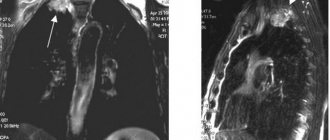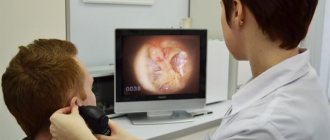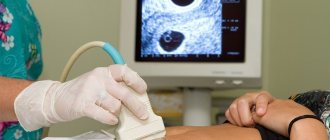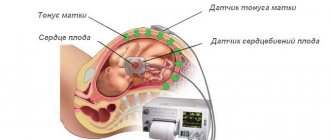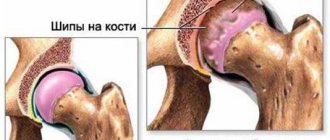Magnetic resonance imaging is a method through which any gynecological diseases are detected. MRI of the uterus determines neoplasms, examines the condition of tissues, bones, and the condition of the woman’s reproductive system.
The main advantage of the technique is considered to be informative: examination of the uterus can find diseases that ultrasound or x-ray methods will not detect. Further it is worth noting the following advantages:
- the procedure is not traumatic, there is no penetration into the skin and tissues;
- does not harm health, unlike x-rays, they are done several times in a row if necessary;
- no research method provides clear data like MRI;
- it is especially important: tomography of the uterus provides a 3-dimensional image, the organ is visible in all projections, this eliminates the possibility that the doctor will not notice the tumor;
- After the procedure, the patient is given pictures and a disk with data that will help the attending physician determine the diagnosis, i.e. information is provided in full;
- a way to determine whether there is cancer - a dangerous disease that needs to be treated in the early stages.
What is MRI of the uterus - diagnostic features
Before the method appeared, health workers used diagnostic methods:
- colposcopy for examination of the cervix;
- hysteroscopy – for examination of the uterine cavity;
- laparoscopy - a method for studying the patency of tubes, ovaries, appendages;
- using contrast - preparation for radiography, CT to determine the presence of adhesions, or changes in organs;
- Ultrasound – to study the condition of the appendages and uterus.
The research method is considered a relatively new technique; diagnostics are carried out in a specially equipped room using a device called a tomograph.
Features of the method include the following aspects:
- During the procedure, clothes are not removed, you will not feel the unpleasant touch of instruments on your body - the method does not bring any unpleasant sensations. A woman just needs to lie still.
- Pregnant women are examined; tomography is a safe procedure.
- MRI of the ovaries is done if there are suspicions of tumors, polycystic disease and other ailments of the organ.
- The doctor receives reliable and accurate research results, MRI determines any disease: from tumors to adhesions. Without tomography, several types of examination would have to be performed at once.
- Contraindications – minimum. Tomography of the uterus is prescribed to the patient even if she has concomitant pathologies. The exception is serious illnesses (for which contrast cannot be used), as well as the presence of medical devices in the body, or if there is anything metal (jewelry, piercings, etc.).
- Determines the presence of bends, neoplasms, scars, allows you to study the external and internal surface of the uterus.
Causes of a malignant tumor
The most important factor in the occurrence of cancer in the cervical canal area is viral infections, of which the most dangerous is infection with the human papillomavirus (subspecies numbered 16, 18, 31, 33 and 45). In addition, risk factors are:
- the beginning of intimate life before the age of 16 with frequent changes of sexual partners;
- smoking (nicotine can accumulate in the cervical mucus, contributing to the malignant degeneration of cells);
- violation of sexual hygiene;
- frequent vaginal infections (colpitis, cervicitis, erosion);
- frequent childbirth and abortion (trauma to cervical tissue);
- decreased immune defense.
In all cases when a cancerous tumor of the cervix is detected, the examination reveals a human papillomavirus infection. But not always, when there is infection with the papilloma virus, there will be cervical malignancy in the near future. This indicates the significance of the virus and associated risk factors.
Which is better - CT or MRI of the ovaries?
MRI of the ovaries is considered a diagnostic method, thanks to which a large number of diseases are detected. The patient is examined to assess the lymph nodes, the condition of the uterus and adjacent organs and tissues. An examination of the uterus and ovaries is prescribed in cases where it is necessary to establish a diagnosis; the patient must have certain indications. MRI is done during routine examinations. The method is expensive, but it allows you to accurately determine the presence of pathology, which is important to do if there is a suspicion of neoplasms.
It is carried out if the doctor suspects apoplexy, endometriosis, or infertility. MRI of the uterus is the only method to determine the presence of tumors with metastases. This is done for mechanical damage to organs.
The technique is safe; special magnetic radiation is used to display images on the tap - they are harmless to humans if there are no metal elements in the body. It is not given to people with mental disabilities or epilepsy. These are contraindications for MRI in women.
CT also allows you to identify gynecological pathologies. Prescribed to patients who suffer from pain, but the cause has not been established. Scanning is a non-invasive diagnostic test that is carried out quickly and painlessly. The advantage of this method is that it provides good detail of blood vessels and soft tissues.
The research method is recommended to be done after an ultrasound scan. They do not use a contrast agent if the patient has allergies, a history of renal failure, or during pregnancy. The radiation dose is low, but harmful to the fetus. Prescribed for suspected neoplasms, damage to organs in the pelvic area, and inflammatory processes.
Based on the above, the conclusion is: MRI and CT are effective diagnostic techniques that identify many pathologies. Computed tomography is not performed on pregnant women; MRI allows examination during this period of time. Only a doctor can determine which method will be more effective, based on the woman’s general condition, the presence of concomitant ailments and other factors.
Why do pregnant women undergo MRI and ultrasound?
Regarding the safety of MRI during pregnancy, the opinion of doctors is extremely unanimous. If a woman asks whether it is possible to do an MRI during pregnancy, the answer in most cases will be positive. The same can be said about ultrasound. Ultrasound diagnostics and magnetic resonance imaging are prescribed to pregnant women everywhere. These diagnostic methods are based on the use of the properties of sound (ultrasound) and electromagnetic (MRI) waves. Neither ultrasound nor electromagnetic radiation have any negative impact on a living organism and are absolutely harmless to both the expectant mother and the baby. The frequency of these studies is not regulated. They are carried out when necessary, but only as prescribed by a doctor.
If you are wondering where you can get an MRI or ultrasound done during your pregnancy, the RIORIT MRI Center and Clinic will be happy to offer its services. In our MRI center, the examination is carried out on an expert-class open-type tomograph Siemens Magentom C. The open contour of the tomograph allows expectant mothers to undergo an MRI examination of the head, spine or joints in a comfortable position with maximum comfort for themselves and the baby. We will be happy to advise you and sign you up for a study at a time convenient for you by phone.
What MRI scans of the uterus and ovaries can reveal
Many women are concerned about the question of what an MRI of the ovaries shows, and whether it is important to do the procedure. The study evaluates the condition of the scar on the uterus after a caesarean section. The study will help determine changes in tissues and organs; in the image, the doctor visualizes the following pathologies:
- ovarian cysts;
- presence of tumors;
- presence of metastases;
- infections, inflammations;
- the presence of adhesions in the fallopian tubes;
- endometriosis;
- MRI always shows uterine fibroids;
- pathologies: congenital, acquired;
- defects of blood vessels, etc.
MRI accurately detects cervical cancer, which is why oncologists often prescribe this method. In the early stages, the risk of premature labor is determined; in case of repeated pregnancy, the doctor prescribes an MRI to assess the condition of the scar after a CS (cesarean section).
Let's take a closer look at what MRI of the ovaries can reveal:
- Benign tumors of the uterus. If a failure occurs in the process of cell division, a tumor forms without metastases. In structural characteristics it is similar to the fabric where it appeared. Thanks to MRI of the uterus, the following types of tumors are determined: fibroadenoma, myoma, fibromyoma, adenofibroma, cystadenoma. Shows whether the neoplasm has a negative impact on neighboring organs.
- MRI of the cervix detects fibroids. It is formed from muscle tissue and can be diagnosed during menopause. It often occurs without visible symptoms. It is carried out if the patient has symptoms - pain in the pelvic area, irregular menstruation, a feeling of discomfort during sex. MRI of uterine fibroids is performed painlessly, according to the doctor’s indications.
- Endometriotic cyst. In the picture it looks like a collection of blood located on the outside of the ovary. The clinical picture is insignificant or pronounced. To make a final diagnosis, the doctor also evaluates the results of ultrasound and laparoscopy.
- Adenomyosis. One of the forms of endometriosis, which occurs against the background of the development of a neoplasm in the muscle tissue of the uterus. Visualizes cysts containing fluid.
- Malignant tumors. Helps determine what is abnormal in the uterus on an MRI. Tissue transformation is noted on all parts of the surface of the uterus. The disease is diagnosed in women under the age of 25. An examination is prescribed if it is necessary to assess how widespread the tumor is and whether there are metastases. If MRI confirms the presence of metastases, a contrast study is performed.
- Problems with reproductive function. The thickness of the uterus, the inner layer, is damaged. Congenital diseases are diagnosed less frequently. Diagnosis of the disease also involves laparoscopy, ultrasound, and hysteroscopy.
Tomography is prescribed to examine the ovaries only in case of suspicion of the above diseases, or during a routine examination. At the moment, this method is one of the most reliable, fast and comfortable.
MRI of the head during pregnancy
Headaches and migraines during pregnancy are quite common. This may be due to hormonal changes in the body, high blood pressure and many other reasons. In order not to miss the symptoms of serious diseases, an MRI of the brain is prescribed. If an MRI of the head was prescribed during pregnancy or an examination of the spine, then the doctor had good reasons for this, and you should listen to these recommendations carefully. As a rule, MRI of the brain is prescribed for head injuries, infectious diseases, problems with blood vessels, suspected brain cancer, suspected aneurysm, vegetative-vascular dystonia, vision problems, suspected multiple sclerosis, symptoms of ischemic stroke.
Timely identification of the problem will help prescribe adequate treatment, and sometimes even save the life of mother and baby. Therefore, having received a referral for an MRI of the head during pregnancy, you should not worry about whether MRI and pregnancy are compatible and whether it is possible to do an MRI of the head in position, but simply trust the experience of a specialist and promptly undergo the examination.
Indications and contraindications for examination
The examination is prescribed to establish and differentiate the diagnosis, to find out whether the woman is ready for a planned operation, and to monitor the condition of the organs after the surgical intervention.
Indications for MRI of the uterus:
- An MRI for uterine fibroids must be done;
- if you suspect an ectopic pregnancy;
- if pregnancy does not occur;
- for cycle disorders;
- presence of tumors;
- if necessary, determine the cause of pain.
Contraindications to MRI for women:
- claustrophobia – during the procedure you need to be in a confined space for some time, this can provoke a panic attack (if an MRI of the uterus is necessary, sedatives are prescribed);
- weight more than 130 kilograms - the device will no longer withstand;
- if there are metal implants, they interact with the magnetic field, this can lead to injury to organs and tissues.
Many people are interested in when an MRI of the uterus is performed. There are certain conditions: it is best to make an appointment from the 7th to the 14th day of the cycle. Not carried out if the patient is on her critical days. When conducting diagnostics with contrast, the doctor must first clarify whether the patient has allergic reactions to the components that are part of the contrast agent.
Detection of sarcoma
Sarcoma is the most aggressive and dangerous type of malignant tumor. It can occur in any part of the body, including the female genital organs. MRI of the uterus, ovaries, appendages and tubes helps to accurately identify the location of the tumor, determine its size and area of damage.
Already during the tomography, an experienced doctor will be able to easily determine the nature of the cancerous tumor. Also, nearby organs will be “captured” in the images. If the patient’s terrible diagnosis is confirmed, the doctor will be able to see if the nearby areas are affected, as well as if the lymph nodes are affected.
How to prepare for the procedure
The procedure for examining the reproductive organs should be carried out with a slightly full bladder. If an MRI of the uterus needs to be done on an emergency basis, no preparation is carried out.
When conducting a routine examination, adhere to the following recommendations:
- Maintain proper nutrition for at least 2-3 days before the procedure. From her diet, a woman should exclude legumes, meat, baked goods and other foods that contribute to the appearance of gas.
- Take laxatives the day before and do a cleansing enema in the morning.
- If the stomach hurts, you need to take antispasmodics; it is forbidden to move during the procedure, and with pain the patient may behave restlessly.
- You should not eat before the examination.
The MRI procedure allows you to assess the condition of the uterus and other organs of the reproductive system. It should also be noted that the main disadvantage of the procedure is its duration - the patient will have to remain motionless for a long time.
Safety of the procedure
Since MRI does not involve the use of ionizing radiation, the woman’s body does not receive any radiation during the study. Therefore, this tomographic examination is safe to perform even on pregnant women. The number of MRI scans that can be done in one day is not limited; they can be combined with other types of hardware diagnostics - ultrasound, radiography, CT.
How is the examination carried out?
MRI of the uterus allows you to determine the presence of tumors and find out whether they are malignant or benign. Many people are interested in learning how an MRI of the uterus is done - let’s look at this issue in more detail:
- Clothing should be spacious, comfortable, light. The presence of metal elements is unacceptable.
- You need to remove all jewelry and piercings, if any. The magnetic field interacts with iron, and this can be dangerous.
- It is prohibited to move during the procedure. You need to lie quietly on your back. You can talk to a doctor - two-way communication with doctors is provided.
The procedure lasts approximately 20-30 minutes. If doctors prescribe an MRI of the uterus with a contrast agent, the examination will take longer. Contrast is administered intravenously using a special catheter. This is necessary when you need to clearly examine the tissues and organs of the reproductive system. MRI of the uterus and appendages is the only procedure that allows you to determine the presence of a tumor with metastases.
Special situations
In some cases, the patient is prescribed an open MRI of the uterus, with sedation or contrast. Let's look at how such studies are carried out, why they are prescribed and other interesting information.
MRI with sedation
When performing an MRI of the uterus, the patient must be completely immobilized. If the condition is violated, the picture will be unclear, and the results of the study will be uninformative. For claustrophobia and increased anxiety, sedation should be used. On an individual basis, the patient is selected with sedatives that will ensure complete rest for the patient, so that possible risks of disruption of the examination can be eliminated.
Open MRI
A special open-type device is used if it is necessary to conduct an MRI of the fallopian tubes and other organs of the female reproductive system. The surface of the tomograph is open on the sides - this is a special device; examinations on it are indicated for people who, for some reason, cannot be in a confined space. The principle of the study remains the same. The advantages are that during the examination, doctors and people accompanying the patient can be present in the room. Another advantage is that the administration of drugs, if necessary, can be carried out directly during the examination.
MRI with contrast
If you need to get the clearest possible image of the area under study, a specialist may prescribe contrast injection. It is imperative to clarify whether the woman is allergic to the drug. MRI with contrast is also performed if other organs and tissues need to be examined. This technique is effective and proven. If there is no individual tolerance to iodine-containing drugs, it is absolutely safe.
Where is the best place to get an MRI?
The most accurate MRI diagnostics of the uterus, ovaries and bladder in clinics in St. Petersburg is carried out using machines with a magnetic field power of 3 Tesla. The cost of such an examination will be quite high, since it requires the use of an expensive ultra-high-field tomograph. To diagnose most diseases of a woman’s genitourinary system, a high-field tomograph with a magnetic field voltage of 1.5 Tesla is suitable. Tomographs of lower power offer cheaper examination, but its quality and accuracy will be seriously inferior to high-field devices.
The MRI and CT appointment service will be happy to help you choose a diagnostic center in a convenient area of St. Petersburg. We will tell you how to do a CT or MRI of the pelvic organs with high quality, quickly and at affordable prices. For a free consultation and to schedule an examination, please contact us by phone. Call us, we know everything about diagnostics in St. Petersburg!
Diagnostic results - interpretation and features
Interpretation of the results obtained should only be carried out by an experienced specialist. Let's consider the features of deciphering some diseases of the female reproductive system:
- Myoma. On the tomogram it has clear boundaries; the edges may be smooth or slightly lumpy. The smallest diameter that nodes can have is 0.3-0.4 cm.
- Hematosalpinx. They are differentiated by the shape and nature of the neoplasm. The wall is thinner than that of an endometrioid cyst. Visually similar to an enlarged fallopian tube.
- Corpus luteum cysts. If they are hemorrhaged, you can see in the picture a dense capsule, the thickness of which varies around 0.5 cm. The contents are of a homogeneous structure, the presence of parietal clots is possible.

